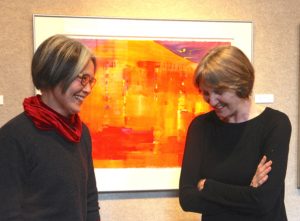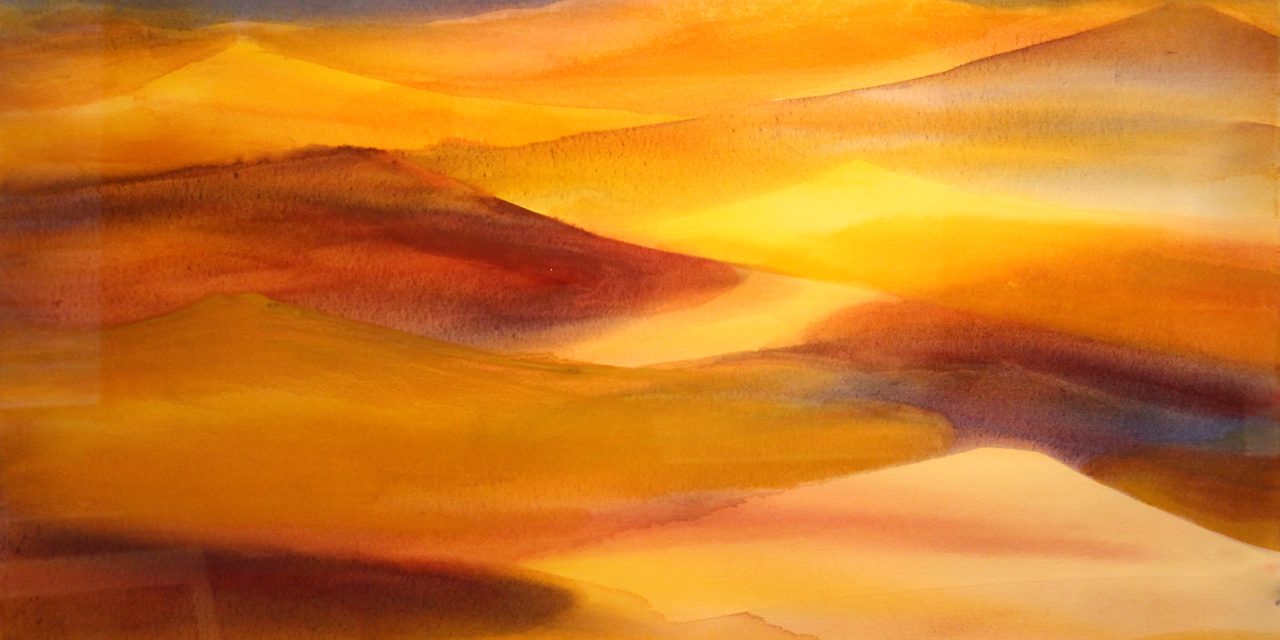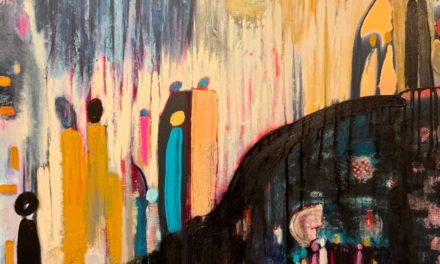(Above: Satoko Motouji’s painting, “After the Sandstorm,” is one of a dozen landscapes that will be projected as backdrops for the Eugene Ballet Company’s production of “Peer Gynt”.)
By Randi Bjornstad
“Peer Gynt” has been a glint in Toni Pimble’s eye for years.
Now Pimble, the artistic director of the Eugene Ballet Company and choreographer of many original dances for the troupe for the past several decades, is bringing her ballet interpretation of the Norwegian folk tale to the stage on April 14 and 15.

Satoko Motouji also created several figural paintings to accompany the landscapes that will form backdrops in the Eugene Ballet Company production; this one is titled “Åse — Peer Gynt’s Mother”
The music is Norwegian composer Edvard Grieg’s imagining of the “Peer Gynt” story, which Pimble said shares some of the same characteristics as the Biblical tale of the prodigal son.
“The story is basically that, of a young, reckless man who lives a thoughtless life and then leaves home because of his mistakes,” she said. “In the end, he realizes his faults and returns home.”
Norwegian author Henrik Ibsen turned the folk tale into a five-act play that first saw publication in 1867. It has dozens of scenes, which range in nature from the høyfjeller — high mountains — of Norway to the subterranean lair of a mythical king served by trolls to the deserts of North Africa.
Turning the story into a ballet was a challenge, Pimble admitted.
“In a play, the actors can describe ideas that don’t really exist in specific scenes, but in ballet it is necessary to distill the core meaning and express it without words,” she said. “I started with Ibsen’s play and had to choose which of the many scenes to put together to make it work, and then match them with the (Grieg) music to make the whole thing flow from one scene to the next.”
That meant the scenes needed to convey the meaning of the story in a non-literal way, and that’s where Satoko Mojouti’s artistry comes into play, Pimble said.
“In many ballets, it works to have just a small number of painted backdrops, but that is not the case with Peer Gynt, where there are so many different places and concepts, and some of the scenes go by so quickly,” she said “Satoko and I started by talking through all the scenes and then she started creating paintings that she thought would represent the story and what the dancers were expressing.”
As a result, Motouji created a series of paintings that can be projected onto the stage as a backdrop to the action, sometimes in quick succession.

Artist Satoko Motouji, left, and Toni Pimble, the artistic director and choreographer for the Eugene Ballet Company, collaborated to provide fine art paintings to be used as backdrops for the ballet’s production of “Peer Gynt”; photo by Randi Bjornstad
“Many of these are abstracted landscapes,” Motouji said. “It was fun to me, and a challenge at the same time. In one case, when Peer Gynt is in Africa, the action takes place in the Bedouin (ruler’s) tent. So there are three abstract paintings for this, first one for the outside of the tent, one to give the feeling of the inside of the tent, and the third, final one to express Peer Gynt’s desperation by being neither in nor out.”
The artist produced 16 paintings to represent 11 of the scenes in the ballet, with several additional scenes expressed in other ways.
“No painting is featured in Peer Gynt’s return to Norway, when he realizes what his life has been so far and what is really important,” Pimble said. “To do that, we will use three banners that will portray the gauze being lifted from his eyes as he finally sees his life clearly.”
Likewise, in the ballet’s shipwreck scene during Peer Gynt’s travels, the storm will be created by projecting a video of the ocean onto the backdrop and using fabric to create waves, she said.
Although she has loved painting and drawing since early childhood, Motouji said her artistic training has been “very unconventional.”
In Japan, where she grew up, she studied English literature along with her drawing classes, “and I studied with a teacher who went to Paris every year, so I learned a lot of Western technique along with Japanese technique,” she said. “That teacher was also very strict — he would not allow the students to hold a paintbrush until he thought they could draw well enough. He would come around and erase their work if he thought it was not good enough.”
After graduation, Motouji became an office worker for four years to make ends meet, then applied for and was accepted to an art history program at the University of Oregon. After completing that agree, she earned a master of fine arts degree in painting at the University of Massachusetts at Amherst. She returned to Eugene in 1985, where she has taught art as well as concentrating on her own painting career, primarily in watercolor and ink.
Motouji is a represented artist at the White Lotus Gallery in downtown Eugene, where her work for the ballet project is on exhibit. The show also includes several paintings of ballet dancers that she created to accompany the Peer Gynt works.
The Ballet — Peer Gynt, by Eugene Ballet Company
When: 7:30 p.m. on Saturday, April 14; and 2 p.m. Sunday, April 15
Where: Silva Concert Hall, Hult Center for the Performing Arts, One Eugene Center (at Seventh Avenue and Willamette Street in downtown Eugene)
Tickets: $30 to $60, available at the Hult Center box office, 541-682-5000, or online at hultcenter.org
The Gallery Exhibit — Peer Gynt: Paintings by Satoko Motouji
When: Through May 12
Where: White Lotus Gallery, 767 Willamette St., Eugene
Gallery hours: 10 a.m. to 5:30 p.m. Tuesday through Saturday
Information: 541-345-3276, lin@wlotus.com, or online at wlotus.com








